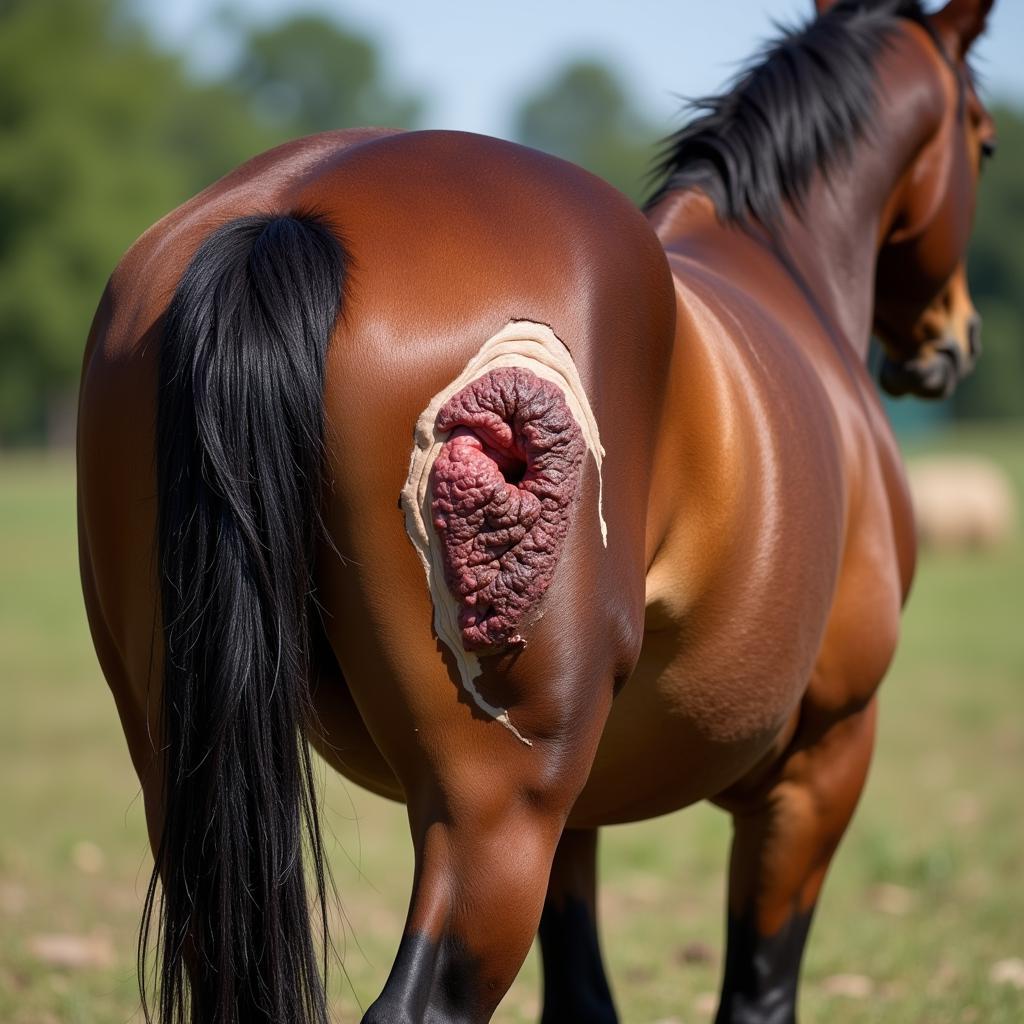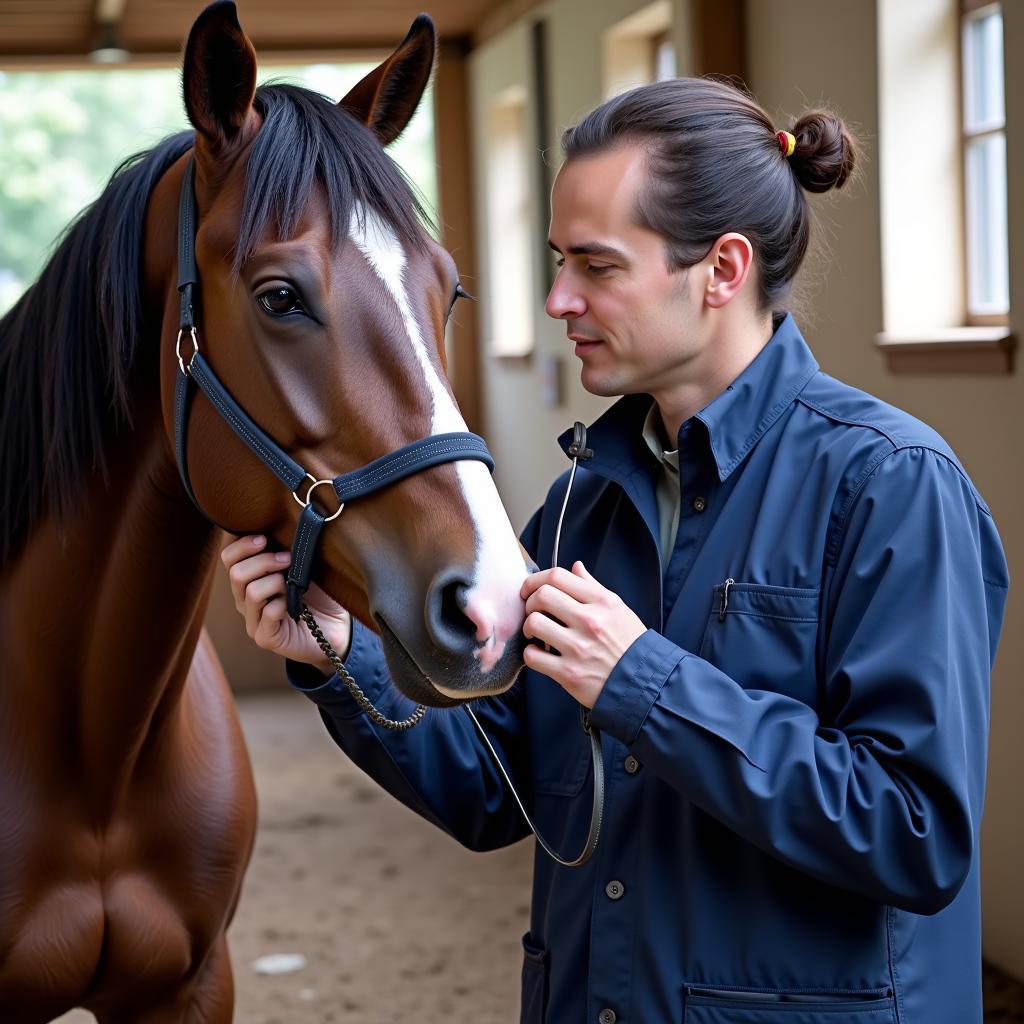Tying up in horses, also known as Exertional Rhabdomyolysis Syndrome (ERS), is a serious condition that can be quite alarming for horse owners. It’s characterized by muscle stiffness, pain, and sweating, often occurring during or after exercise. But what exactly causes a horse to tie up? Let’s delve into the common causes and understand how to identify and manage this condition.
Understanding Equine Tying Up: Causes and Symptoms
 Horse Showing Tying Up Symptoms
Horse Showing Tying Up Symptoms
Tying up primarily stems from a disruption in muscle metabolism during exercise. Several factors can contribute to this:
- Genetic Predisposition: Some breeds, like Thoroughbreds, Quarter Horses, and Arabians, are genetically more susceptible to certain forms of tying up. This predisposition often involves how their muscles store and utilize energy.
- Electrolyte Imbalances: Electrolytes, such as potassium, calcium, and sodium, are crucial for proper muscle function. Imbalances, often caused by sweating during exercise, can trigger tying up episodes.
- Dietary Deficiencies: Inadequate levels of Vitamin E and selenium, essential antioxidants for muscle health, can increase the risk of oxidative stress and muscle damage, potentially leading to tying up.
- Overexertion: Pushing a horse beyond its fitness level, especially after a period of inactivity, can overload their muscles, making them prone to tying up.
- Underlying Medical Conditions: Certain infections, hormonal disorders (like Equine Polysaccharide Storage Myopathy), and even some medications can increase a horse’s susceptibility to tying up.
Recognizing the Signs: Is Your Horse Tying Up?
Early detection is crucial for effective management of tying up. Look out for these signs, particularly during or after exercise:
- Stiffness and Reluctance to Move: Horses with tying up often exhibit a stiff gait, especially in their hindquarters, and are reluctant to walk or move freely.
- Muscle Tremors and Sweating: Visible muscle trembling, often accompanied by profuse sweating, is a classic sign of tying up.
- Rapid Heart Rate and Breathing: The horse’s heart rate and respiratory rate may increase significantly due to pain and stress.
- Dark or Coffee-Colored Urine: In severe cases, muscle damage can lead to the release of myoglobin, a protein that turns urine dark brown or reddish.
If you observe any of these symptoms, it’s crucial to stop exercising your horse immediately and contact your veterinarian. Prompt veterinary attention is vital for diagnosis and treatment.
 Veterinarian Examining Horse with Tying Up
Veterinarian Examining Horse with Tying Up
Managing Tying Up: Prevention and Treatment Strategies
While tying up can be a recurring issue for some horses, proactive management can significantly reduce the frequency and severity of episodes. Here’s what you can do:
- Gradual Exercise Program: Avoid sudden increases in exercise intensity or duration. Implement a gradual and consistent exercise program, allowing your horse’s muscles to adapt.
- Balanced Diet and Electrolyte Supplementation: Provide a balanced diet that meets your horse’s nutritional needs. Consult your veterinarian about appropriate electrolyte supplementation, especially during periods of intense training or hot weather.
- Adequate Warm-up and Cool-down: Always ensure a thorough warm-up before exercise and a gradual cool-down period afterward to prepare muscles for exertion and aid in recovery.
- Manage Underlying Conditions: If your horse has an underlying medical condition contributing to tying up, work with your veterinarian to manage it effectively.
- Genetic Testing: For breeds prone to genetic forms of tying up, consider genetic testing to understand your horse’s risk factors and tailor management strategies.
When to Seek Veterinary Care
If you suspect your horse is tying up, immediate veterinary attention is crucial. Treatment often involves:
- Pain Relief and Muscle Relaxants: Medications to alleviate pain and reduce muscle spasms are typically administered.
- Fluid Therapy: Intravenous fluids are often provided to address dehydration and support muscle recovery.
- Nutritional Support: Your veterinarian may recommend dietary adjustments or supplements to support muscle health and prevent future episodes.
Tying up can be a complex condition, but with proper understanding, management, and veterinary care, you can help your horse live a healthier, more comfortable life.
Frequently Asked Questions about Tying Up in Horses
1. Can a horse fully recover from tying up?
With prompt and appropriate treatment, many horses can recover fully from tying up episodes. However, repeated episodes can lead to long-term muscle damage and increase the risk of future occurrences.
2. Is tying up the same as colic in horses?
While both conditions cause discomfort and distress, they are distinct. Colic refers to abdominal pain, whereas tying up specifically involves muscle stiffness and pain.
3. What is the best way to prevent tying up in horses?
A multifaceted approach involving a balanced diet, electrolyte management, gradual exercise, and addressing any underlying medical conditions is key to preventing tying up.
4. Are certain types of exercise more likely to cause tying up?
Intense bursts of speed, like sprinting or jumping, can increase the risk of tying up, especially in susceptible horses.
5. What should I feed a horse prone to tying up?
Horses prone to tying up often benefit from diets lower in carbohydrates and higher in fat, along with appropriate electrolyte supplementation. Consult your veterinarian for specific dietary recommendations.
Do you have other questions about horse health and care?
Check out these related articles on our website for more helpful information:
Remember, at Justus Horses USA, we are committed to providing you with the most accurate and up-to-date information to help you care for your equine companions. If you’re concerned about your horse’s health or need personalized advice, don’t hesitate to contact us. Our team of experts is here to assist you 24/7. Call us at 0772127271, email us at [email protected], or visit us at QGM2+WX2, Vị Trung, Vị Thuỷ, Hậu Giang, Việt Nam.